Ballyneal Golf and Hunt Club
COLORADO, USA
Head Golf Professional: Matt Payne
Green Keeper: Dave Hensley
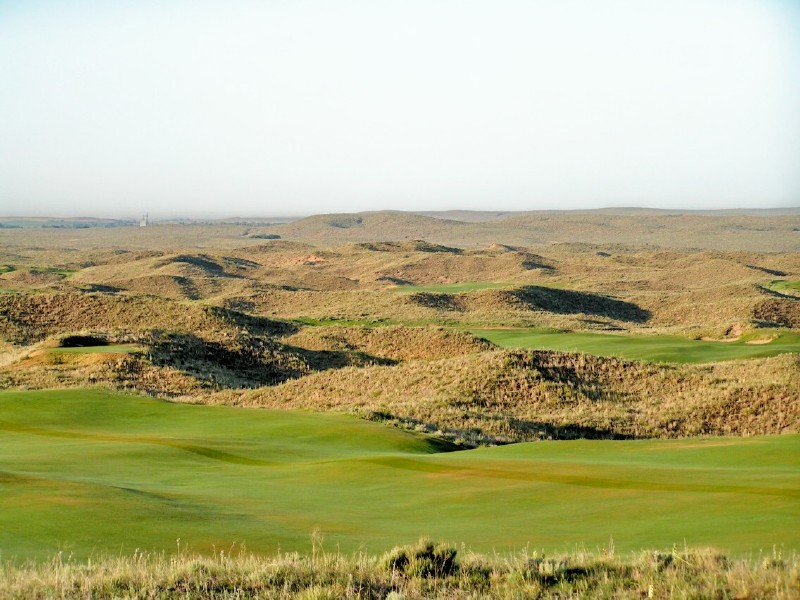
Be it the view from the coastal road as one approaches Portrush or here in the ‘chop hills’ in northeast Colorado, nothing inspires golfers more than the sight of fairways weaving and tumbling through ageless sand dunes.
Golfers who grew up watching the Open on television in the mid 1970s through the mid 1990s were nearly always in for a treat. There was the epic Watson vs. Nicklaus at Turnberry which was just the start of Watson’s great run, the thrill of watching Seve Ballesteros, the generation’s most exciting player, win three Opens, the star-studded Open at Royal St. George’s when Greg Norman’s talent went fully rewarded.
Some of the silliness with contrived course set-ups (i.e. fairways that were too narrow) such as at Carnoustie and Royal St. George’s had yet to occur. Rather, man left well enough alone. If the summer was hot and dry, firm playing conditions and hopefully wind provided the challenge. Some years, when Mother Nature didn’t cooperate and the wind died down, the winning score would be quite low like when Nick Faldo dissected the Old Course at St. Andrews – and that was fine too.
Watching Faldo’s complete control over every shot or Ballesteros’s hit it and go find it approach were equally inspiring in their own way, at least a young Jim O’ Neal certainly thought so.
He also thought that the sand dunes down the road from his family’s farm in Holyoke, Colorado weren’t too terribly dissimilar from the ones that he saw on television. Nearly 30 years later, Jim and his brother Rupert have brought this dream of bringing the best playing attributes that the game has to offer – wide, fast running fairways, hazardous hazards, and wild greens – to these very sand dunes near their family farm.
For an architect, they hired Tom Doak and his Renaissance Golf Design. Anyone who has read Doak’s The Confidential Guide knows of his appreciation for such playing conditions, making him an obvious choice. Doak in turn has handsomely rewarded the O’Neal brothers and the founding members of Ballyneal with a golf course that takes as much advantage of the ground contours as any course built since World War II.
As Doak has oft stated within the Discussion Group of this web site, his favorite hazard is short grass as it doesn’t strike fear into the lesser player though it does in the more accomplished one. Be it Pinehurst No. 2, Royal Dornoch, Rye, or the West Course at Royal Melbourne, many of his favorite designs are highlighted not by rough but by wide playing corridors of short grass. Most golfers get on or near the greens in regulation on such courses with the real challenge only just beginning as the green complexes are replete with humps, bumps, hollows, banks and shoulders that send the ball every which way. Played from short grass, the variety of recovery shots far exceeds that of merely hacking out of thick rough. And who doesn’t enjoy the chance to the invent shots and make a fantastic recovery like Ballesteros?
Many modern architects grasp why this type of golf is so much fun. Having the ability to translate this broad ideal into the dirt is quite another matter, with very few modern architects showing the ability to follow nature’s lead.
As much as anything, Ballyneal is about the love of the land and that means different things to different people. To Rupert O’Neal, a long time farmer in Hoyloke, he appreciates what the land will accept including water requirements to keep grass from dying and drainage requirements given that one is building on twenty feet (!) of sand. Also, he knows what times of year the wind is likely to blow the strongest from what directions, which plays into knowing which directions exposed bunkers must face to avoid too much sand blowing out. To his brother Jim, now the Head Golf Professional at the elegant Meadow Club north of San Francisco, it means appreciating the qualities in the ground that lend themselves to good golf, the kind of golf that people never tire of playing. No conversation with Jim on golf lasts too long before he mentions the word ‘fun’ and how much fun the game is meant to be. And to Tom Doak, this project was a dream: 700 acres of sandy dunes at his disposal, no housing considerations with which to contend, and no cart path considerations either as Ballyneal embraces the traditional values of this great – (i.e. walking) game. Plus, at 3,700 feet of elevation, the wind from the high Colorado plain would always be about and the dry summer heat could help promote firm playing conditions.
Holes to Note
First hole, 380 yards; One of the finer positioned tees in golf, the back tee for the 1st hole is just off the practice putting green and creates a thrilling diagonal carry across a valley to a 75 yard wide fairway. The placement of the tee in relation to the fairway may remind one of the famous 1st at Macrihanish. Like all the holes at Ballyneal, the wide fairway does not mean that care need not be taken from the tee in selecting the right line given the day’s playing conditions. For instance, a tee ball that ends up within ten paces of the right edge of the fairway may leave the golfer with a blind approach over a mound whereas a tee ball that hugs the left may be gathered into a bowl, leaving another blind approach shot. The overall effect is near perfection for a golf course architect to seek: the modest golfer sees plenty of fairway and swings away with confidence whereas the tiger golfer appreciates more of the hidden perils and the need for care and thought.

The thrilling diagonal at the 1st – does one go at the flag or well right? The day’s wind will play a big part in the decision.
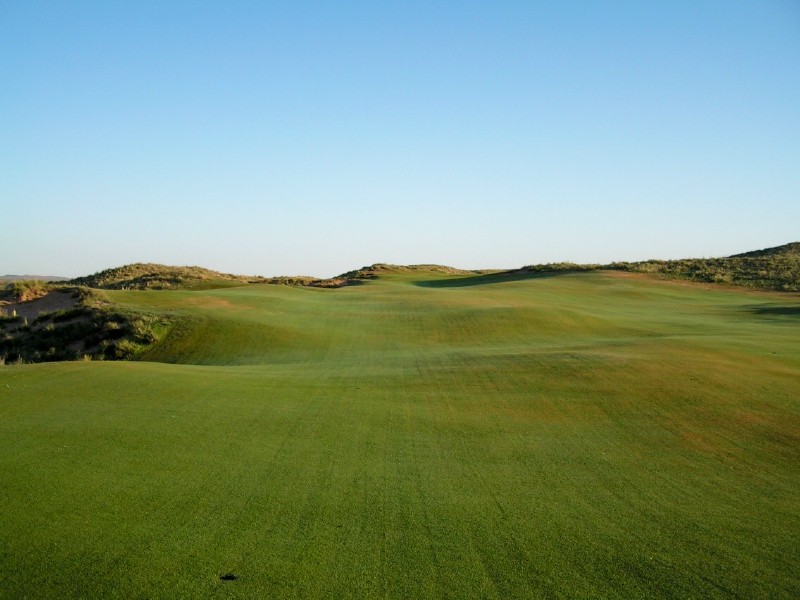
The first of many beautiful fairway contours as captured within the 1st fairway. The high mound on the right obscures views of the green from the right side of the fairway whereas…

…in downwind conditions, a tee ball down the left may be gathered into this bowl, leaving a blind pitch to a green that falls off on all sides.
Note: the area between the 1st green and the 2nd tee says much about Ballyneal. The distance is 40 paces and it is maintained as all short grass. The course is replete with many such short green to tee walks, a must as Ballyneal is walking only. The sound of golf carts chugging around is mercifully absent and no cart paths mar the landscape. Despite the undulating nature of the property, Ballyneal is a pure delight to walk, a compliment to Doak’s routing and the work that was done with the dunes. Also, the grass combination of fescues and colonial bent coupled with the ~10 degree slope that feeds off the 1st green is ideal as the ball may end up 5 feet down the slope or 15 feet or perhaps 25. The better golfer will select a different type recovery shot based on exactly where the ball finishes. As the ball will never finish in the same spot twice, all facets of the better golfer’s short game will be tested over time. Other courses in recent times have opted for short grass around their greens too but the slope is often too severe or the grass type is incorrect to yield the desired range in recovery options. The final point worth noting in this area is that Doak’s crew had to fill in several feet in the hollow between the 1st green and 2nd tee and change the bank leading up to the 2nd tee, all for the sake of accomplishing the aforementioned points. Yet, absolutely no one can discern that any such work was done in this area by man, an attribute that puts Renaissance Golf Design at the top of their profession.
Second hole, 490 yards; The prairie states of Colorado, South Dakota, Nebraska and Kansas enjoy wind, a crucial element for any great course and one of the reasons why several of the finest courses that have opened in America in the past decade are found in those states. Of course, the architect must present holes at various angles to the prevailing winds and the holes must play equally well in most winds. Even better is when the architect can use the landforms to make holes play dramatically different from day to day. Bill Coore famously accomplished this at Sand Hills, a two hour drive from here at the 16th which can be a driver/three wood hole in the morning and a driver/three wood/one iron in the afternoon. Similarly here at the 2nd, Doak’s routing takes maximum advantage by incorporating the tumbling landscape into fairway from 200 yards from the tee through to 300 yards. The 2nd tee is the highest point on the course and an evening walk had the 2nd playing driver/ three wood and then some into the wind with the tee ball staying well back up the hill while a morning game had it playing driver/wedge. Imagine that – a nine plus club difference! Clearly, members and their guests will be presented with a course of many different looks and moods during their three or four day stay at Ballyneal.

The perfect tee ball at the 2nd bounds all the way downhill and leaves the golfer within 150 yards of the green. Into the wind, the hole becomes a different proposition.
Third hole, 145 yards; Played at a ninety degree angle to the 2nd, the 3rd is an extremely attractive one shotter. One might think that the bunkers would be cut closer to the putting surface on this modest length one shotter but that is to miss the point. In a windy location, care must be taken with the proximity of large bunkers to the putting surface due to sand blowing. Plus, a tightly bunkered putting surface only accepts a certain type shot. Here, with the green sunk in its own amphitheatre, the tightly mown banks between the bunkers and putting surface provided the golfer with numerous ways of reaching certain hole locations. A much more fascinating array of decisions and possible shots exist as a result.
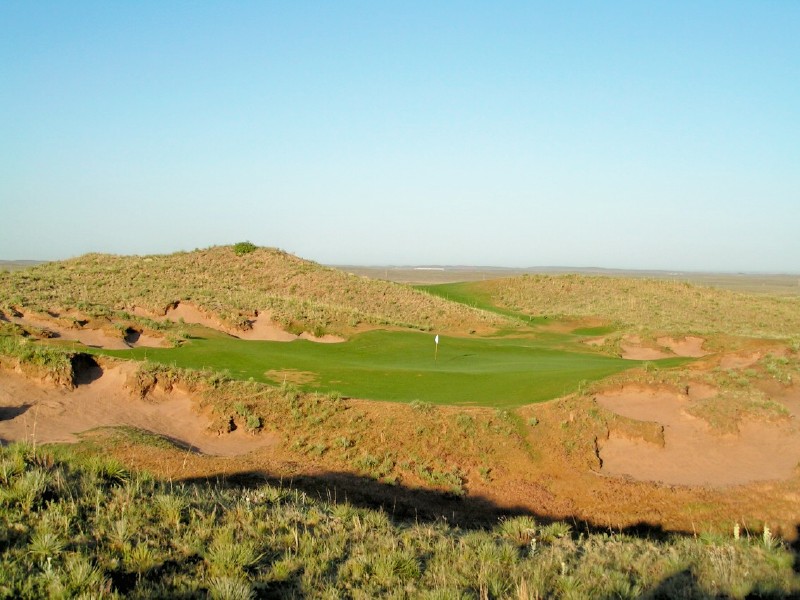
With no outside disturbances, the golfer is always free to appreciate the beauty of the course.

How best to get close to this hole location – swing it in using the left bank, or use the mound behind the hole location as a back stop or hit to the middle of the green? The day’s wind will figure in one’s decision making.
4th hole, 560/465 yards; Ballyneal’s free flowing teeing areas are most admirable as sharply defined rectangular tee areas would seem silly/contrived/out of place in the wilds of northeast Colorado. Even more interesting is the O’Neal brothers desire to forgo tee markers altogether. The member and his group are free to play the course from whatever tee area they wish, mixing it up throughout the round as they see fit. This freedom of choice makes for some particularly interesting discussions when playing the 4th as it has the largest yardage difference between the back and middle teeing areas of any hole. The 4th, 5th, 6th and 7th holes were the last holes to fall in place for Doak’s routing and the excellence of the 4th green location played a big part in his deciding to proceed with this as his final routing.
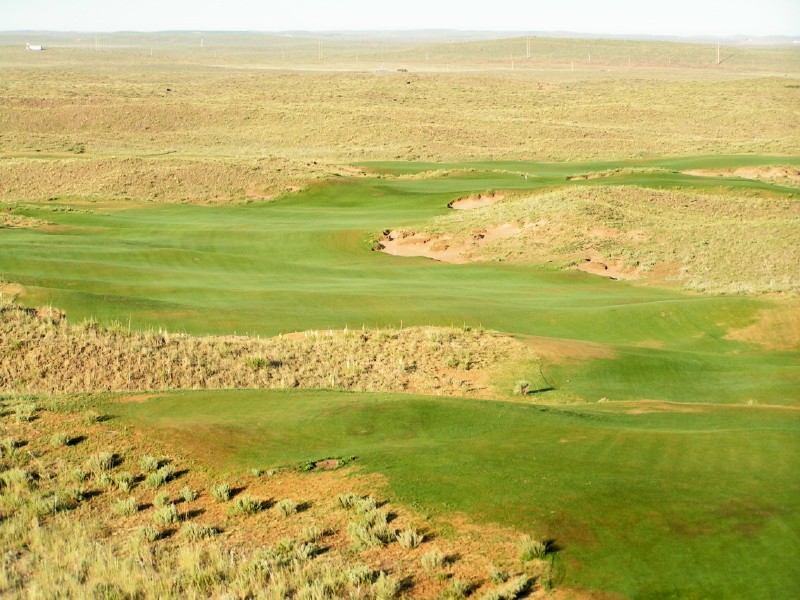
The grand sweep of the 4th fairway, which is nearly 100 yards wide in spots and 75 feet below the elevated back tee markers. The green site atop a ten foot dune is one of the finest on the course.
5th hole, 160 yards; In complete contrast to the 3rd hole, a single small bunker dominates the play of this one shotter. Though one of the smaller greenside bunkers on the course, its placement flush against the front middle of the putting surface makes its presence play ‘big.’ The ground contours are such that an approach that lands well short of the 5th green can access the very interesting left hole locations.
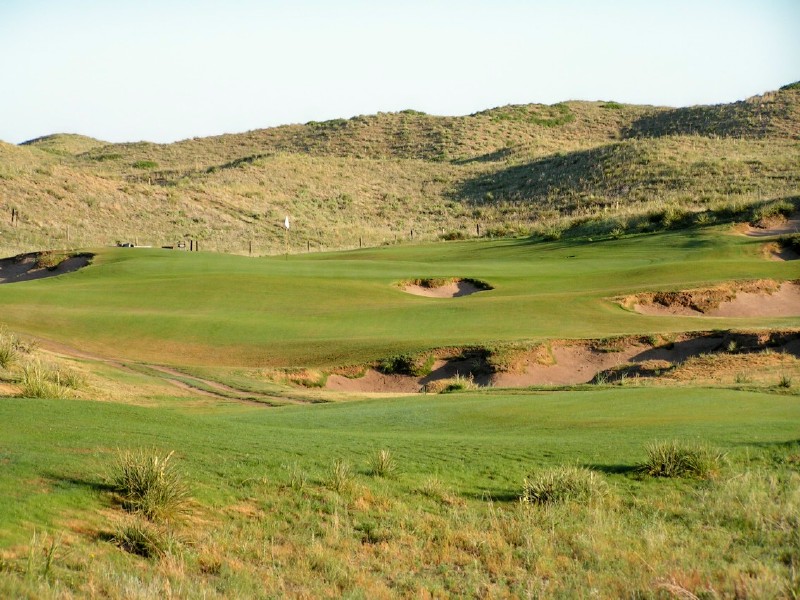
The key playing attributes of the 5th are the small bunker flush against the putting surface and the green, which is high in the left and middle before falling away toward the back.
6th hole, 480 yards; The tee area is below the level of the fairway, leaving an appealingly blind tee ball over the brow of a ridge to a wide fairway. Far too many modern architects build elevated tees ad nauseam with the effect of giving the holes a similar perspective, thus unintentionally rendering the holes less distinctive from one another. One of the great surprises of the course occurs farther ahead at the green, which features very bold interior contours, a rarity for a hole of such length.
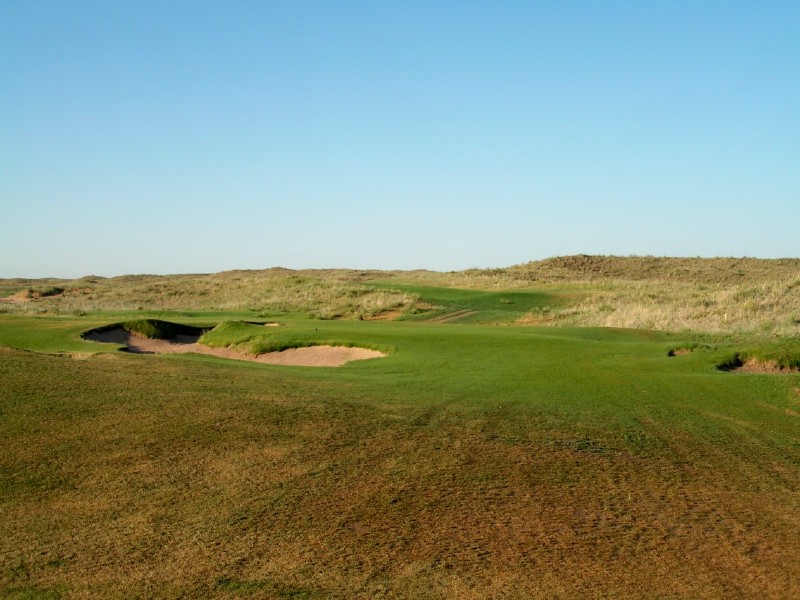
Only a hint of the fairway is seen from the 6th tee. The fact is masked from the tee that the 6th fairway is (relatively speaking!) the flattest part of the property that Doak elected to route a hole.

With many of the greens open in front and appearing to be nothing more than extensions of the fairway, it is impossible to overstate how many fun and varied approach shots can be played at Ballyneal. Throw in some of Renaissance’s boldest interior putting green contours like here at the 6th and the golfer gains a new appreciation of the ground game.
Seventh hole, 335 yards; Already the favorite hole of many members and perhaps the favorite of Tom Doak’s as well, the 7th is a half par hole of the sort that drives the better golfer into poor decisions. Downhill and often downwind, the golfer sees the flag between the shoulder in a dune and the shoulder of the large central fairway bunker. If the golfer carries this foreboding bunker 100 yards from the green, there is a relatively good chance that his tee ball will get a positive kick toward the green and get near or on the putting surface. The putting surface is shaped like an ‘E’ with numerous interesting hole locations. Using the banks around the green to work the ball toward certain hole locations will become one of the favorite tasks during a game at Ballyneal. Some courses (falsely) pride themselves on the difficulty of their more famous holes. In this case, this world class hole is also one of the easier pars on the course, a sure sign that Ballyneal is first and foremost about having fun and enjoying the game.
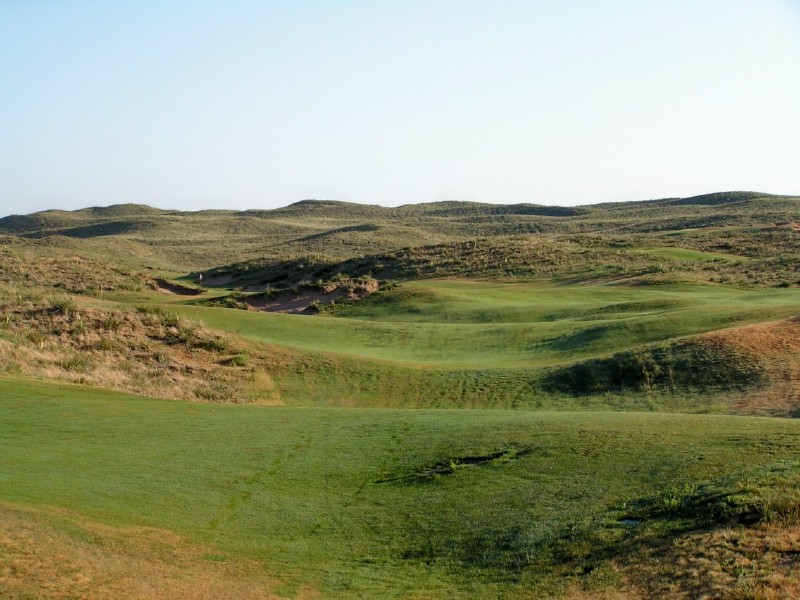
The flag is visble from the tee at the 7th and is seen in the left middle of the photograph above. Initially, a green complex was considered up near the 8th teeing area, as seen in the right side of the photograph.

The large looming fairway bunker (of which only its left half is in the photograph above) obscures a full view of the 7th green which sits in a natural hollow.

The key moment in the evolution of the 7th was when Doak determined that the bank to the left of the green be cleared of all native grasses and vegetation. At that point, all kinds of interesting opportunities presented themselves for bank shots and the fingers in the right of the green were created.
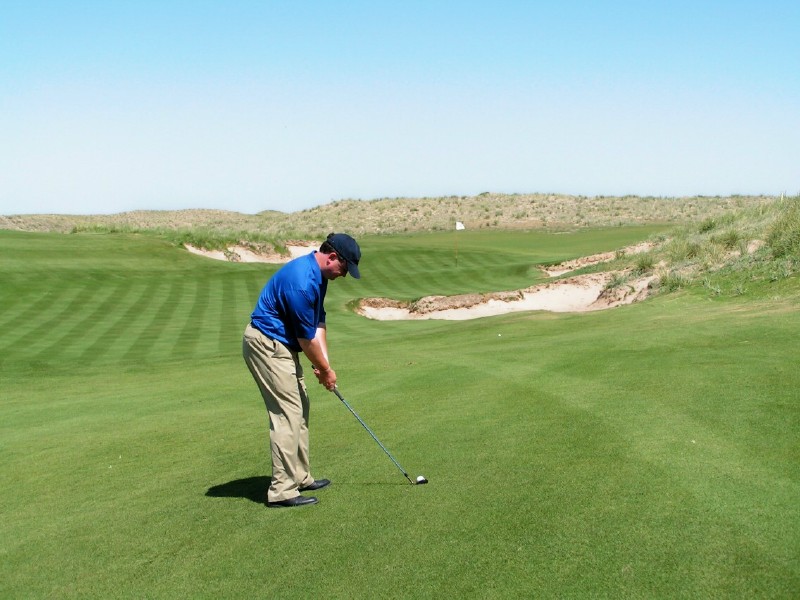
Laying up with a three wood has done this golfer no favors, as he is left with a horrible angle for his forty yard pitch. Cleverly though, he uses the mound…

…behind the hole to feed his pitch back to within six feet of the hole.
Eighth hole, 515 yards; Ballyneal has four holes with center line bunkers – the 7th, here at the 8th, the 13th and 14th holes. That statement may imply that it is clear sailing down the other fairway and nothing could be further from the truth as the topography that Renaissance Designs created/preserved in the fairways presents as much – or more – strategic challenge off the tee than bunkers. However, when the golfer is confronted with center line bunkers, they are among the deepest hazards on the course, particularly at the 7th and 8th holes. This forty-five yardlong Sahara bunker formation is located 210 yards from the 8th green and is in play 1) off the tee when the hole is downwind, 2) on one’s second when the hole is into the wind, or 3) on one’s second when one’s tee ball fails to find the wide fairway. Once past this impressive bunker complex, gobs and gobs of room exists but the green is angled along the base of the dune from front left to back right across the line of play.
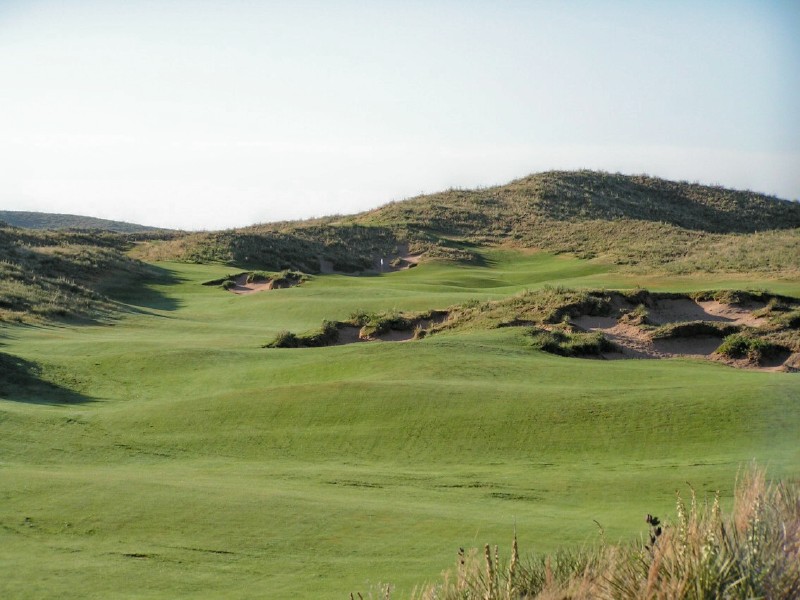
Because of the wide playing corridors, the Sahara bunker complex at the 8th may not seem that fearsome from the tee but…

…closer inspection proves otherwise!
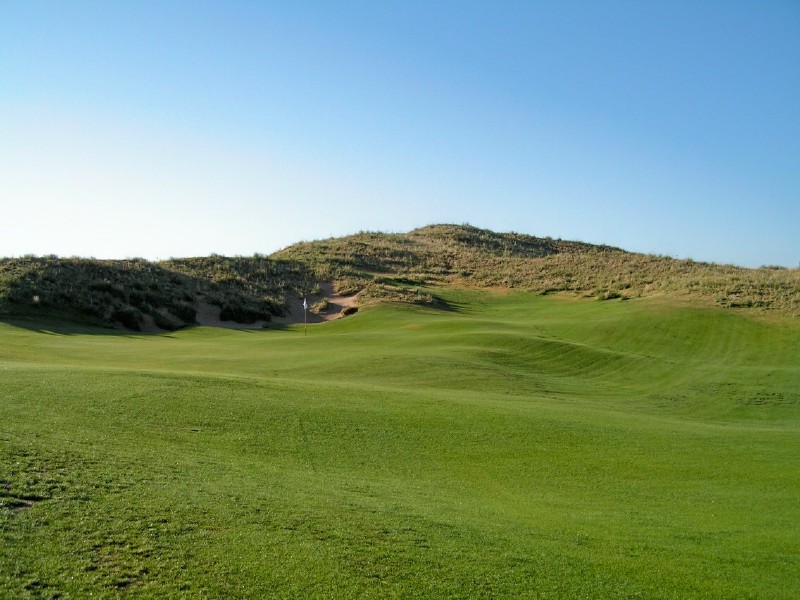
The interior contours of the 8th green become increasingly pronounced as the green goes uphill along the base of the dune.
Ninth hole, 360 yards; One can only imagine the enormous difficulty in routing 18 consecutive holes of a highquality across this landscape. Known to the locals as the ‘chop hills’, the abruptness in some of the dunes often gave way to drop offs that were too steep to create playing features of any great merit. Ceratinly, the landformslent themselves to plenty of great holes scattered here and there but remember: Ballyneal is a walking only course and the distance from green to tee needed to be at a minimum. Because an access road was already in place, the location for the clubhouse and lodging for Ballyneal was one of the easier decisions. From that spot,playing corridors for holes1, 8, 9, and 10were among the first that the Renaissance design team found on the property.However, though the 450 yard long playing corridor between the 8th green and 10th tee ran through a natural valley, it didn’t lend itself to a hole of good golfing qualities as a highdune shoulderon the left gave way to an abrupt drop off.In short, there was no place for a tee ball to land. What shouldRenaissance do? Scrap this routing and look for another one? Or alter the dunescape for the sake of yielding the best string of golf holes possible? Once the decision was made to cut the dune down and fill in to create a fairway with good playing qualities, the key was in the execution to make it look like the dunescapehad never been disturbed.
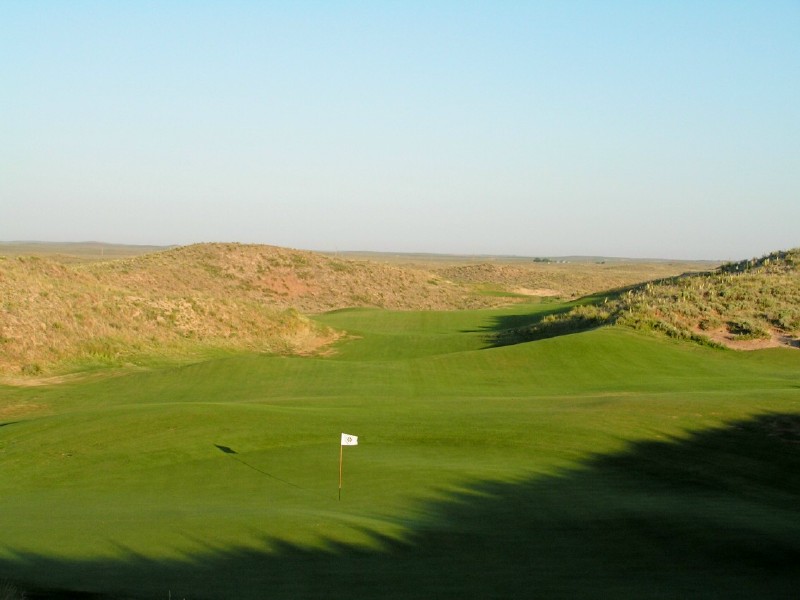
As seen from behind the green looking down the valley of the 9th hole, no one can tell what was or wasn’t moved, such is the skill that Renaissance brought to the project.
Tenth hole, 510/460 yards; A really clever design with the bunkers and topography used in concert to creategreat playing angles. An ideal drive carries a large fairway bunker on the inside of the dogleg and gains the most level stance in the fairway as well as a perfect view of the long green between two dunes. The golfer who thinks that the center line of the fairway is fine will find that the right to left fairway slope kicks his tee ball farther left and likely down into a large bowl in the fairway. The approach shot is now blind over a large bunker complex some 100 yards shy of the green. The green contours are among the best anywhere with the green appearingas anextension of the fairway.
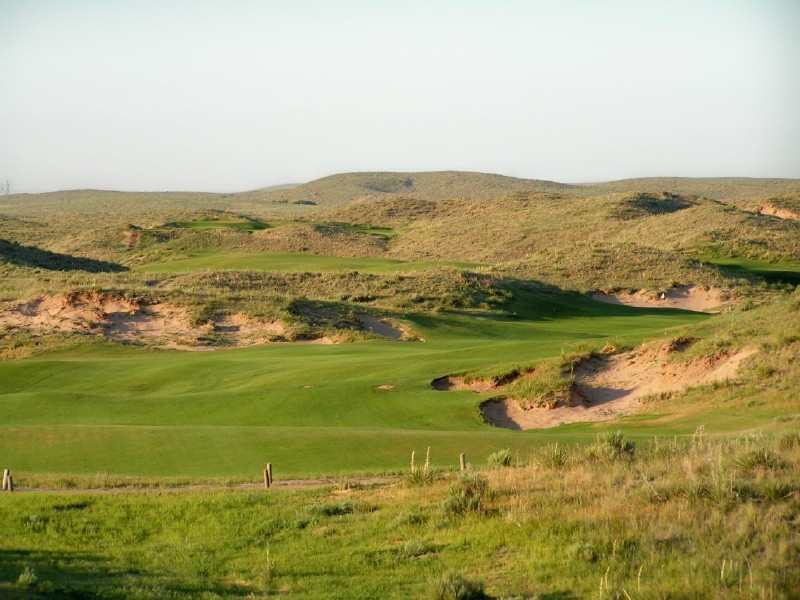
There is 30 yards of fairway over the bunker on the inside of this dogleg to the right. The white flag is visible in the distance and is clearly visible from the upper right side of the fairway. Of course, the strong right to left fairway slope and contours …
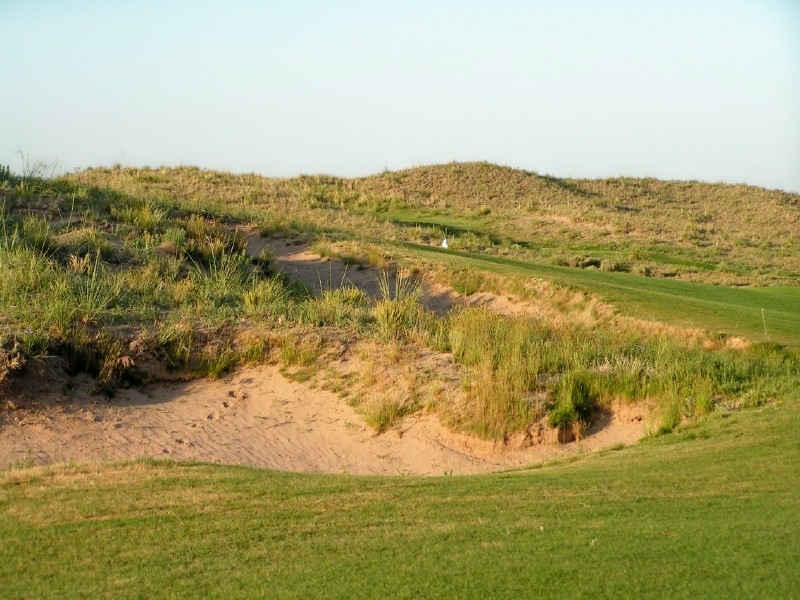
…feed balls left, often leaving a blind or nearly blind approach.
Eleventh hole, 165 yards; Nobody knows just how good – or how hard – Ballyneal will become. Take the 11th hole for instance which plays from dune top to dune top. Asthe course matures, and as Green Keeper Dave Hensley works his magic, golferswill come to fear the front hole locations at the 11th as anything just short willlikely roll twenty orthirty yards down the hill.Indeed, thegolfer will hope aslightly mishit tee ball ends up in the front bunker. Fortunately though the putting surface is large, giving the golfer plenty of opportunity to show the front bank respect by hitting well onto the green and getting down in two putts from fifty feet. This hole highlightsthat the principal challenge of the course isindeed theshort grass. It also highlights the fact that sometimesthe golfer will be surprised as to exactly where his ball ends up!

The beautiful sight of the 11th from the tee, or at least it’s beautiful until one’s tee ball comes up short and trickles down the fairway and well away from the green.
Twelfth hole, 365 yards; Ballyneal occupies a homogeneous piece of property in the sense that it is all rumpled and rolling sand dunes. A challenge for the architect is to imbue each hole with its own identity while providing the golfer with a variety of different decisions to mull over. One of the best ways to accomplish that is by incorporating the landforms into the holes in various manners. Here at the 12th a dominant ridge runs from one o’clock to seven o’clock down the fairway. The shortest line to the green is along the high, left side of the fairway, precisely where a bunker pinches in. If the tee ball stays up on the high left side, the golfer’s approach is from the same level as the green and he enjoys a fine angle.The less fortunate golfer whose tee ball catches the fairway ridge and is pushed right has an approach fromwell below the level of the green and must contend with the greenside bunkers. As befitting a hole of this length, the green is among the more severe on the course with the high front mound within the green giving way to the back lower putting surfaces.
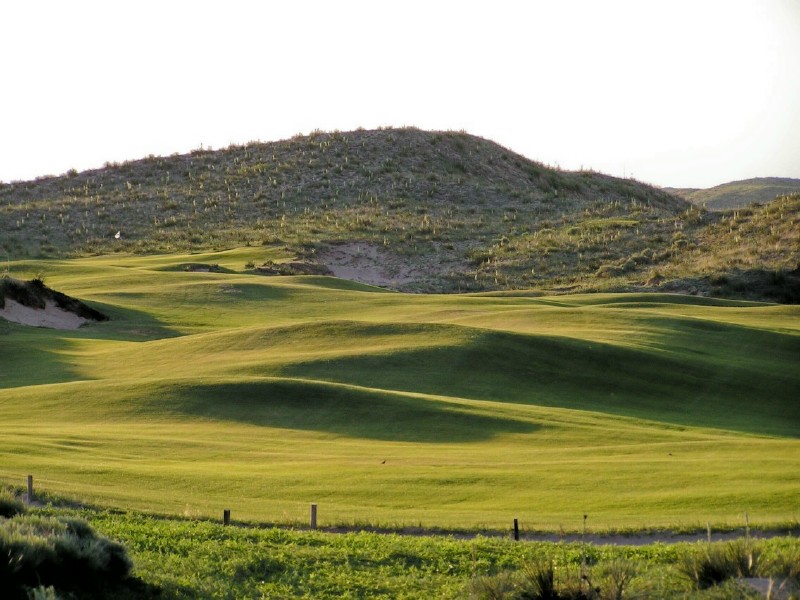
Late afternoon shadows highlight the stunning fairway contours at the 12th.
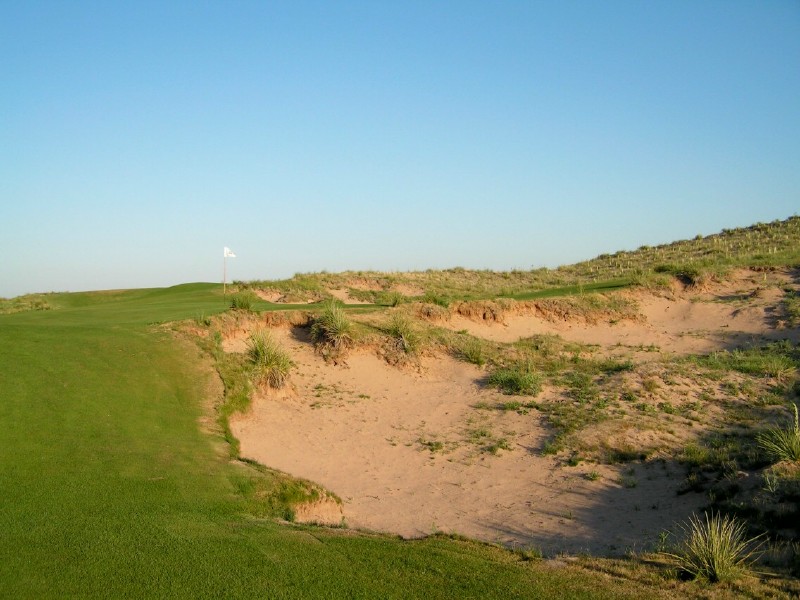
As seen in the two photographs above, the greenside bunker at the 12th materializes out of the natural dunescape.
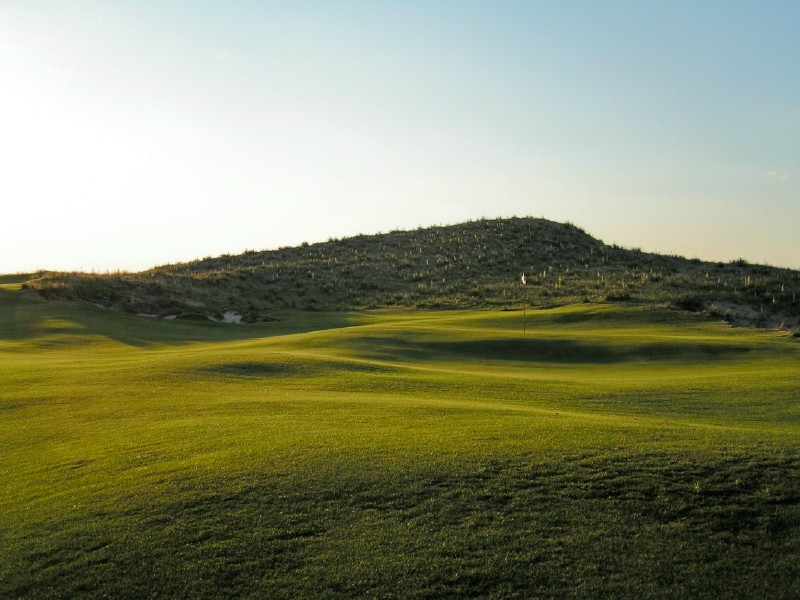
As seen from its left front, the putting surface at the 12th is guaranteed to challenge the golfer, regardless of how short his approach shot.
Thirteenth hole, 420 yards; Ballyneal is an expansive course, effortlessly sprawling across 280 (!) acres of dunes land. Even though the golfer may have become accustomed to its scale, the 13th remains breathtaking, featuring both the widest fairway on the course at100yards and the largest green at 11,000 square feet. Withfour fairway bunkers (i.e. bunkers surrounded by fairway) randomly cut into the bold fairway contours, the golfer may come to think he has never seen a hole remotely like it anywhere in the world. Bruce Hepner, project manager for Renaissance at Ballyneal andfresh off great success at Cape Kidnappers in New Zealand, called the Ballyneal project the great ‘meltdown.’ By that, he meant the land was so rich with natural features but many were too abrupt for good golf.Renaissance had to ‘melt’ those features down through cut and fill all the while making it look like none of the landscape had been touched. As one can see in the photograph below, they succeeded brilliantly.

Even the elevated tee can’t mask how undulating the wild 13th fairway is.
Fourteenth hole, 360 yards; A very interesting hole as it presents an endless riddle of how best to play it. The golfer can flirt with the dominant hillside bunker for the sake of gaining both the shortest approach shot as well as the most level stance. The rub is that the putting surface is blind from that angle. Conversely, the golfer can drive well right toward the outside of the dogleg, thus avoiding any of the bunkers as well as perhaps gaining a good look at the bunkerless green. The challenge though lies in the humps and bumps in the fairway where any stancemay result. Through trial and error, each member will determine which way yields the better results.
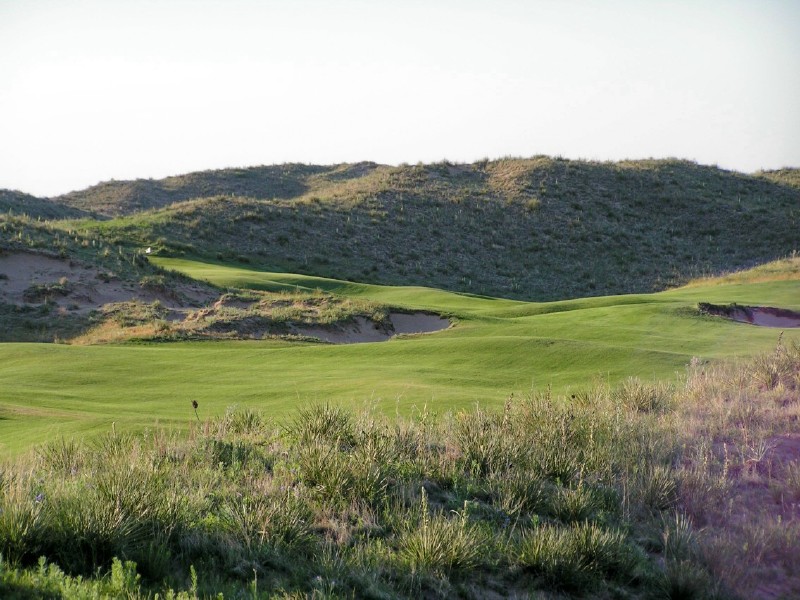
The sight of the flag lures the golfer left off the 14th tee but is that the best angle…

…to approach this bunkerless green? Maybe, maybe not.
Fifteenth hole, 235 yards; Thanks to the variety found within the four holes, the 15th completes the finest set of one shotters that Renaissance has designed in the United States. Similar with the bunker to the right of the 12th green, the bunkers cut from the dunes left and right of the 15th green are works of art as they evolve out of the dunes themselves – where nature ends and man’s hand begins is indiscernible, the very highest form of golf coursearchitecture. Nonetheless, this hole is really about the ground game with the opportunity to bounce tee balls in from the left or right into this green which sits in a hollow. As the green runs from front to back and as the slopes that feed onto the green are pronounced toward the front, front hole locations will take members quite a bit of time to figure out how best to get near. Indeed, somedays the golfer might be trying to figure out a club on the tee that will land the ball a good 50 (!) yards short of the middle of this gigantic green and let the land do the rest.
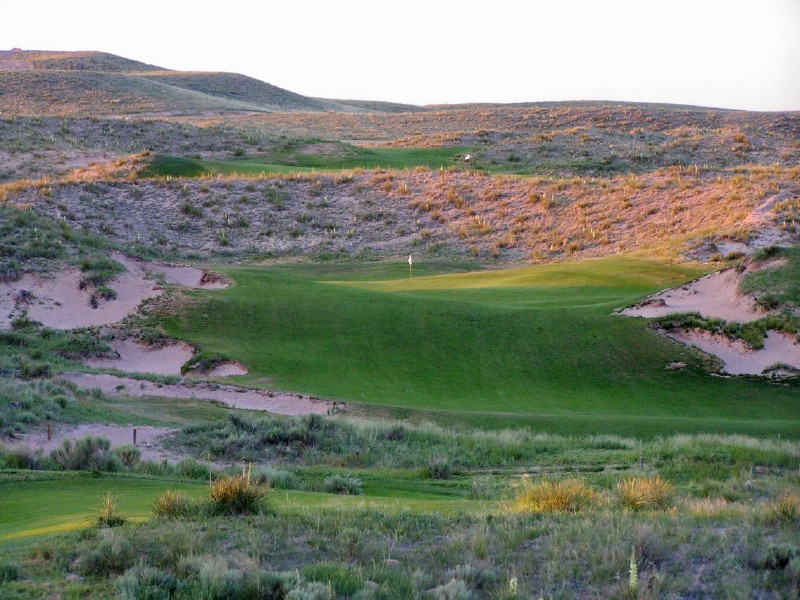
As seen at sunset, the long one shot 15th features a green in a natural bowl. The ridge in front of the green is actually 30 yards short of the front of the putting surface.
Sixteenth hole,540 yards; The golfer is now in the midstof the most dramatic dunes on the course and one consequence is that this hole has the ability to change the most in terms of difficulty of any on the course. On calm or days with a helping wind, the golfer has hopes of hitting to the crest of the far hill. From there, the golfer turns left and has a beautiful view of the fairway running through a ‘V’ between two large dunes to an elevated green some 240 yards away. Thoughts of birdie are entertained. However, with a less than helpful wind, the picture for one’s second shot changes drastically. One is now at the base of thefifty foot hill, facing a blind shot that might need to squeeze between the two aforementioned dunes. Rather than accept that challenge the golfer is free to lay up before the fairway narrows and is left with 140 yards to the uphill green.
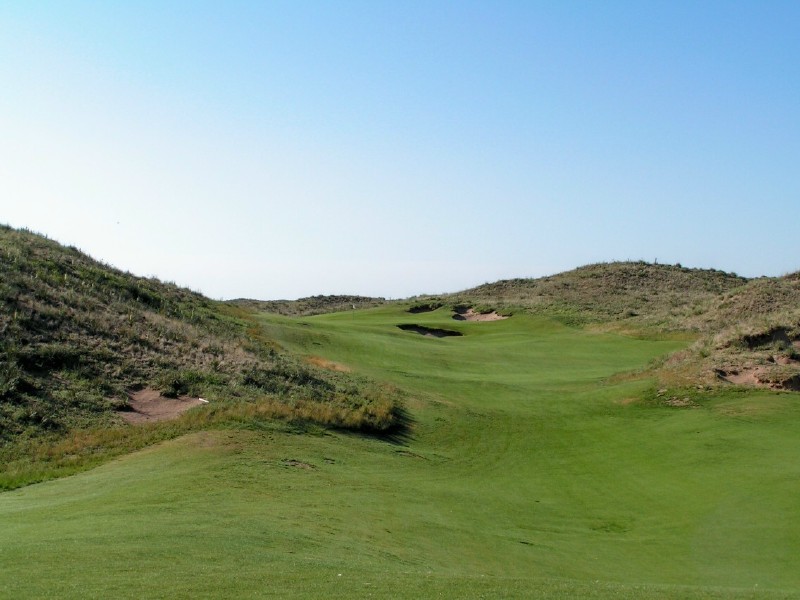
The 16th fairway bends sharply toward the left around 400 yards from the tee and narrows as it squeezes between two dunes. If the golfer can get past this gap in two, a pleasant outcome may await.
Seventeenth hole, 460 yards; Not unlike the 9th, the 17th fairway required a good bit of work to make it play well for golf. In working withthe land, the design team at Renaissance came up with yet another varied fairway/ playing strategy. The golfer will ideally seek to stay on the upper level of the fairway, which happens to be on left side of the fairway on this hole which swings to the right. Should the tee ball catch the ridge in the fairway and be kicked right, the difficulty of the golfer’s task is compounded by the angle of the green and the front greenside bunker.
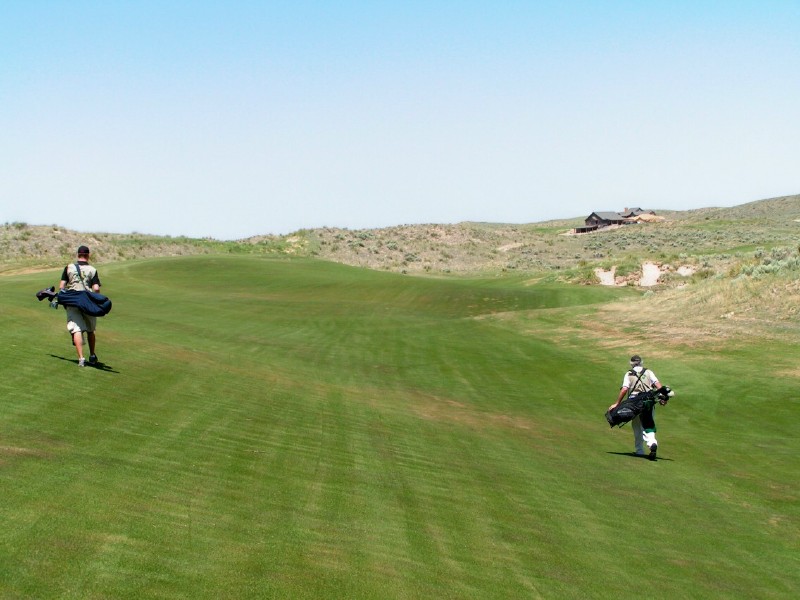
The relation of the caddies to one another speaks as to the severe left to right slope in the middle of the 17th fairway. Not only can the approach shot be blind from the lower right side because of the bunker in the photograph below…
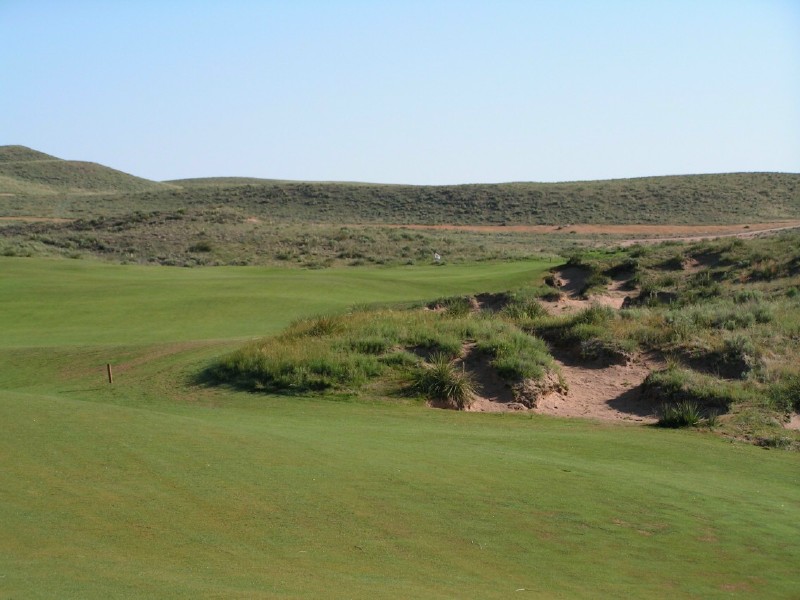
…but the green also sets up best for approaches that come in from the left.
Eighteenth hole, 465/410 yards; The 17th and 18th holes head in the same general north/northwest direction and the golfer’s task is quite different based on the day’s wind direction. A very fine playing angle is created from the middle tee area. Downwind, the golfer glances well up the fairway, trying to figure just how much he can shorten the hole. As little as a wedge may see him home. Into the wind, this uphill hole becomes altogether sterner as the greenside bunkering is the deepest on the course, consistent with the steep bank leading up onto the green.
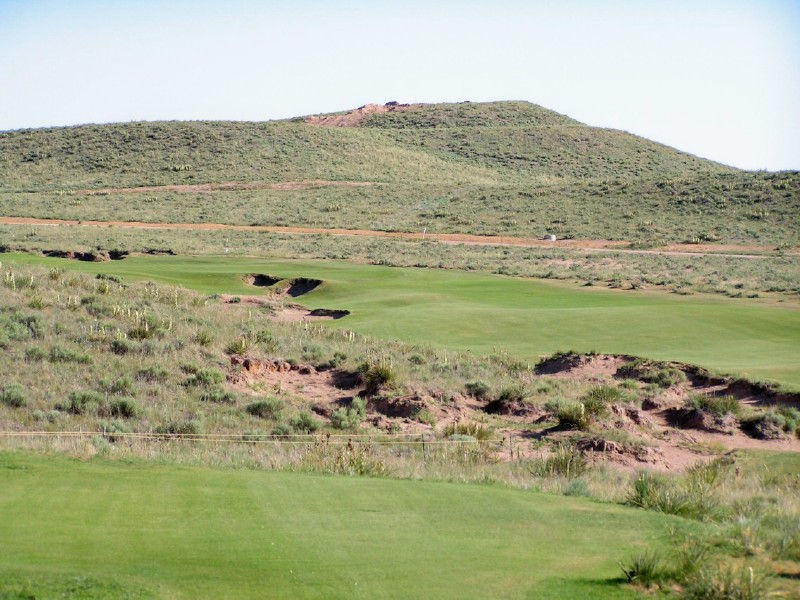
The line that one wishes to take from the middle tee varies wildly based on the wind. Though the two greenside bunkers are cavernous, there is plenty of room to come in from the right.
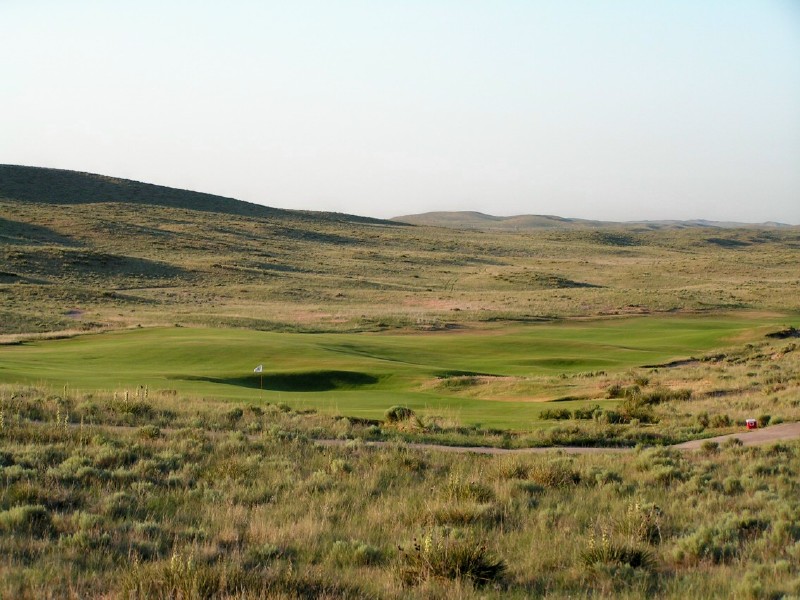
Looking back down the 18th from near where a porch will soon be, one is especially taken by the contours perserved within the fairway.
In a seven year period, Renaissance Design has worked onfive of the world’s most spectacular sites. First, there was Pacific Dunes, then came Barnbougle Dunes along the Tasmanian coastline andCape Kidnappers on the North Island of New Zealand, hereat Holyoke, and finally Sebonack in posh Southampton, Long Island. As to which is the better site, each has its own admirers but more than one person considers the site at Ballyneal to be the finest property with whichRenaissancehas ever worked. Of course, those who insist on water views will disagree but there is no arguing that 1) Jim O’Neal’s original vision was accurate that the sand hills in northeast Coloradolent themselves to exhilarating golf, 2) the O’Neal brothers hired the right design firm given the final product and especially since the dunes look completely undisturbed by the hand of man at the end of the project and, 3) Alister MacKenzie is the only other golf course architectto havebuilt five courses of such world class quality in such a short period of time.
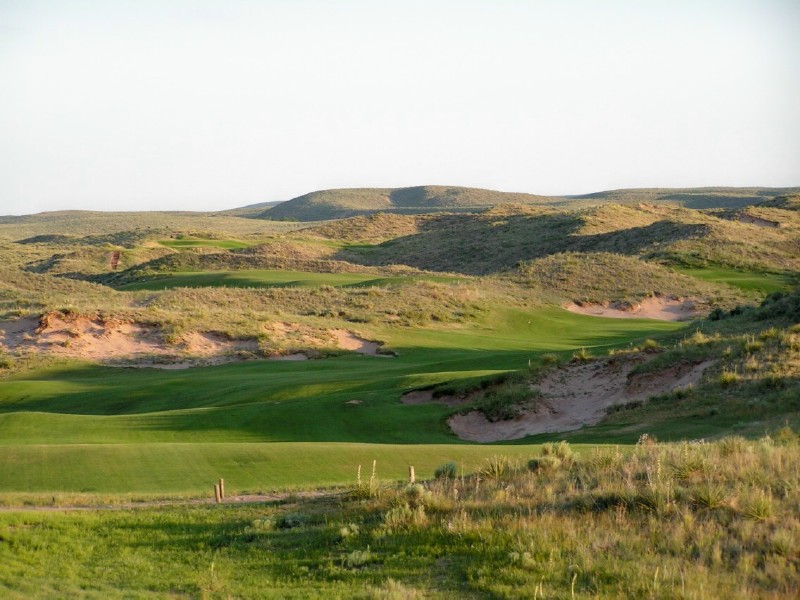
As photographed from the 10th tee a little after 8:00pm one June evening, what golfer wouldn’t grab his bag and head out for a few more holes after dinner?
The End





![The Park, West Palm (Lit 9) [2023]](https://golfclubatlas.com/wp-content/uploads/2024/12/IMG_7092-2-scaled-500x383.jpg)


